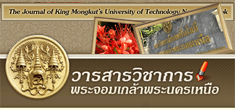Abstract
The work is to study the effects of load, sliding distance and water absorption on wear properties and mechanism of wood/PVC composites. The experimental results indicated that the weight loss increased with an increasing load from 250 to 500g. When applying the load at 1000g, the weight loss increased at sliding distance of 0.5-1.5 kilometers followed by stability at sliding distance of 1.5-2.0 kilometers. The longer sliding distance resulted in the greater the weight loss in the wood/PVC composites. The worn surface of wood/PVC composites at loading 250g and 500g at 0.5-1.5 kilometers for sliding distance showed wear mechanism of Polyvinylchloride, and that ago 1.5-2.0 kilometers sliding distance, the wear mechanism result from wood flour effect. The three-body abrasion occurred at the load of 1000g at 0.5-1.5 kilometers sliding distance. The transfer film improved wear properties at 1.5-2.0 kilometers sliding distance. In case of the water absorption, the unscrubed specimens had more water absorption than the scrubbed specimens. The weight loss increased due to the increasing of specimen volume and density by water absorption. As a result, the weight loss was high at 3% water absorption. The mechanical wear involved with chemical reactions on the PVC surface. The wear mechanism at 6% and 9% water absorption involved wood resistance effect and abrasive three-body effect, respectively.
The work is to study the effects of load, sliding distance and water absorption on wear properties and mechanism of wood/PVC composites. The experimental results indicated that the weight loss increased with an increasing load from 250 to 500g. When applying the load at 1000g, the weight loss increased at sliding distance of 0.5-1.5 kilometers followed by stability at sliding distance of 1.5-2.0 kilometers. The longer sliding distance resulted in the greater the weight loss in the wood/PVC composites. The worn surface of wood/PVC composites at loading 250g and 500g at 0.5-1.5 kilometers for sliding distance showed wear mechanism of Polyvinylchloride, and that ago 1.5-2.0 kilometers sliding distance, the wear mechanism result from wood flour effect. The three-body abrasion occurred at the load of 1000g at 0.5-1.5 kilometers sliding distance. The transfer film improved wear properties at 1.5-2.0 kilometers sliding distance. In case of the water absorption, the unscrubed specimens had more water absorption than the scrubbed specimens. The weight loss increased due to the increasing of specimen volume and density by water absorption. As a result, the weight loss was high at 3% water absorption. The mechanical wear involved with chemical reactions on the PVC surface. The wear mechanism at 6% and 9% water absorption involved wood resistance effect and abrasive three-body effect, respectively.
Keywords : Wood/PVC Composite, Wear, Flooring Products




